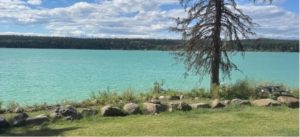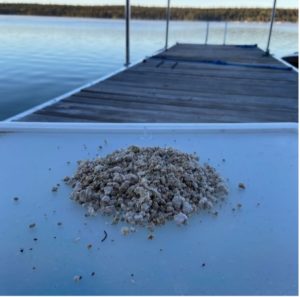Interesting Information
The Colour of Chimney and Felker Lakes, Summer 2025
CFLLA Lake Stewardship Committee
The blue-green colour of Chimney and Felker Lakes this summer is caused by tiny marl crystals suspended in the water column. This was first explained to me by Biologist Tom Wilkinson. This summer the lake water changed colour in early July. In 2024 the colour change did not occur until late August. The timing of the lake colour change is affected by the water temperature, lake algae and weather conditions.
Chimney Lake on August 19, 2025. The blue-green colour is caused by tiny marl crystals suspended in the water column.

Coarse marl from the bottom of Chimney Lake along the northeast shore. The same coarse marl occurs along the northeast shore of Felker Lake.
Chimney and Felker lakes are marl lakes. The ground water that enters the lakes is saturated with calcium carbonate. The calcium carbonate is dissolved from the limestones that underly the lakes and surrounding area. The uplands around the lakes are covered by glacial till which overlies 2 to 6 million year old plateau basalts. A 200 million year old limestone underlies the plateau basalts. This is the same limestone that you can see along the road in the Marble Canyon between Hat Creek and Lillooet. This limestone comes to surface at a location along the southwest shore of Chimney Lake.
When you boil Chimney and Felker lake water in a kettle a scale eventually forms on the bottom and sides of the kettle. This is the calcium carbonate from the lake water. When the lake level subsides, you can see the whitish calcium carbonate coating on the rocks along the shore.
As well as the tiny marl crystals that form in the lake water, the calcium carbonate in the lake water forms marl deposits on the lake bottom a few meters from shore. Along the northeast shores of both Chimney and Felker lakes there is coarse marl, shown in the photo above. This forms a hard lake bottom.
Along the southern shores of Chimney and Felker lakes there is more sediment inflow which mixes with the marl, making a softer lake bottom.
Marl was first described in lakes in central England where it was dredged and ground up to make the first Portland Cement.
The calcium carbonate in the lake water is probably good for us. Our bones are composed of calcium phosphate so the lake water could be a source for the calcium. However I am a Geophysicist, not a Nutrition or Metabolic expert, so this could be nonsense. I drank Chimney Lake water until I was 18 years old with no obvious ill effects. And, at 76, my bones are still sound.
Gerry Mitchell
Chairman, CFLLA Lake Stewardship Committee.